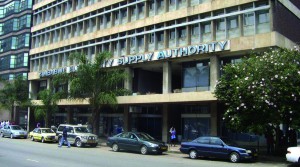Source: ZESA escalates power imports | The Financial Gazette September 14, 2017

ZESA Holdings headquarters
AN escalation of imports by ZESA Holdings resulted in a 444 percent surge in electricity purchases to $221 million last year, as the country’s power utility sought to close the generation gap and avert power blackouts, the company’s 2016 financial statements show.
Power purchases amounted to $41 million the previous year, but low output at Kariba due to low water levels reduced generation. ZESA board chairman, Herbert Murerwa, said in a statement accompanying the group’s annual report that ZESA had increased imports due to low water levels at Lake Kariba, which resulted in poor electricity generation at Kariba Power Station.
Zimbabwe has a peak demand of 1 400 megawatts (MW) daily, but is generating about 1 000 MW on av – erage. To cover for the shortfall, the country is importing 300 MW from South Africa’s Eskom and up to 50 MW from Hydro Cahora Bassa of Mozambique. Murerwa said: “Electricity purchases were recorded at $220,9 million during 2016 compared to $40,6 million that was recorded in the year 2015 due to increased im – ports caused by low water levels at Lake Kariba.
“This was mainly due to the drought induced reduc – tion of generation at Kariba South Hydro Power Station and the aged equipment that resulted in frequent system failure and numerous forced outages at Hwange Power Station.” Imports increased to 2 295,57 GWh in 2016, from 636,487 GWh the previous year, as ZESA sought to augment the shortfall. ZESA’s power generation unit, the Zimbabwe Power Company (ZPC), supplied 6 779,16 GWh, which was seven percent below the production target of 7 297,43 GWh. This was also 26,44 percent below the 2015 output of 9 215,42 GWh, according to Murerwa.
The country’s largest coal fired power station pro – duced 2 917,06 GWh in 2 016, 22 percent down on the 3 720,81 GWh produced the previous year. Kariba Power Station supplied 3 472,79 GWh com – pared to 4 938,13 GWh in 205, translating to a 30 percent decrease. Harare Power Station transmitted 116,64 GWh during 2016 compared to 209,15 GWh in 2015. Munyati Power Station supplied 162,14 GWh in 2016 compared to 173,28 GWh, while Bulawayo Power Sta – tion produced 110,53 GWh compared to 174,05GWh in 2015. The balance was provided by independent power producers, who increased their generation contribution to 277,725 GWh, from 53,782 GWh in 2015, an increase of 416,39 percent.
As a result of this, exports decreased by 61,35 percent to 371,099 GWh in 2016, from 960,148 GWh in 2015. The debt owed to ZESA increased to about $1,180 bil – lion in 2016, from $1,087 billion the previous year, resulting in reduced funding for recapitalisation and operations. Consequently, ZESA deferred implementation of capital projects and reduced maintenance of infrastructure thereby “threatening security of supply and growth in the revenue base”, Murerwa said.
The group’s total debt went up 11 percent to $1,193 billion during the period under review from $1,076 billion recorded the previous year. “Delayed payment to suppliers and the group’s failure to service foreign loans, which were classified as current liabilities, resulted in a net liability position of $649 mil – lion, thus creating a situation of uncertainty on the going concern status of the group of companies,” said Murerwa.
ZESA, which could have made a loss of $157 million during the period under review, recorded a net profit of $63,9 million from a $48,1 million loss recorded in 2015, due to a reversal of allowance for credit losses amounting to $239,9 million.
This was after government committed to settle balances owed by various government departments, parastatals, local authorities and government subsidy to Sable Chemicals. Revenue for the group decreased by two percent to $833,3 million compared to the previous year, due to suppressed internal electricity generation.
ZESA chief executive officer, Josh Chifamba, said the “business fundamentals are not right”.
“The current tariff does not provide sufficient revenue to cover operational costs and the problem is further compounded by inadequate revenue collection. The absence of cost-reflective tariffs remains a major obstacle in addressing sector viability in order to attract the much needed public and private investment in the electricity sector.
“The tariff has remained stagnant since 2011 to 2016. A tariff review was declined despite the increase in costs occasioned by the reduction in output at Kariba and the introduction of diesel power,” said Chifamba.
COMMENTS